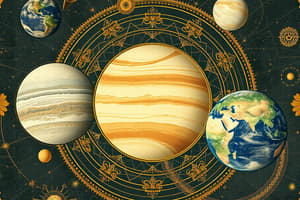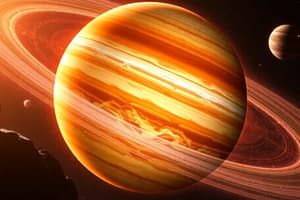Podcast
Questions and Answers
Why is Venus referred to as Earth's twin?
Why is Venus referred to as Earth's twin?
- It is similar in size and structure to Earth. (correct)
- It is the only other planet in our solar system known to potentially support life.
- It has the same axial tilt as Earth, leading to similar seasonal patterns.
- It has a similar atmospheric composition to Earth.
Although Mercury is closer to the sun, why is Venus hotter?
Although Mercury is closer to the sun, why is Venus hotter?
- Venus's core produces more internal heat than Mercury's core.
- Venus has a higher albedo, reflecting more sunlight and trapping more heat.
- Venus's slower rotation allows for more even heat distribution across the surface.
- Venus has a thicker atmosphere composed of greenhouse gases, which traps heat. (correct)
What is a unique characteristic of Venus's rotation compared to Earth and most other planets?
What is a unique characteristic of Venus's rotation compared to Earth and most other planets?
- Venus has no rotation; it is tidally locked with the Sun.
- Venus rotates in the opposite direction (retrograde) compared to Earth and most other planets. (correct)
- Venus's rotation is highly irregular, varying significantly over long periods.
- Venus rotates much faster than most planets, resulting in very short days.
Which of the following best describes the surface conditions on Venus?
Which of the following best describes the surface conditions on Venus?
What is the main reason Venus is so bright in the night sky?
What is the main reason Venus is so bright in the night sky?
Why is exploring the surface of Venus particularly challenging for spacecraft?
Why is exploring the surface of Venus particularly challenging for spacecraft?
What is the primary focus of Japan's Akatsuki mission currently in orbit around Venus?
What is the primary focus of Japan's Akatsuki mission currently in orbit around Venus?
Which of the following describes the composition of Venus's atmosphere?
Which of the following describes the composition of Venus's atmosphere?
What is the name of the NASA mission planned for a probe landing on Venus in 2031, and what is its primary focus?
What is the name of the NASA mission planned for a probe landing on Venus in 2031, and what is its primary focus?
Which mission was the Soviet Union's that set the record for longest time survived on Venus's surface?
Which mission was the Soviet Union's that set the record for longest time survived on Venus's surface?
NASA's VERITAS mission is designed to do what?
NASA's VERITAS mission is designed to do what?
What is Venus named after?
What is Venus named after?
What is the planned launch year for NASA's VERITAS mission?
What is the planned launch year for NASA's VERITAS mission?
What is unique about the length of a day on Venus?
What is unique about the length of a day on Venus?
What was the first spacecraft to visit any planet beyond Earth?
What was the first spacecraft to visit any planet beyond Earth?
What are the DAVINCI spacecrafts two onboard instruments used for?
What are the DAVINCI spacecrafts two onboard instruments used for?
What would the atmospheric pressure on Venus feel like compared to Earth?
What would the atmospheric pressure on Venus feel like compared to Earth?
What is the surface temperature on Venus?
What is the surface temperature on Venus?
While the DAVINCI mission is underway, what will the DAVINCI spacecraft serve as?
While the DAVINCI mission is underway, what will the DAVINCI spacecraft serve as?
What nation is responsible for the EnVision orbiter?
What nation is responsible for the EnVision orbiter?
Flashcards
What is Venus?
What is Venus?
Venus is the second planet from the sun and Earth's closest neighbor. It is a terrestrial planet, small and rocky.
Venus' Atmosphere
Venus' Atmosphere
Venus has a thick atmosphere full of greenhouse gas carbon dioxide and yellowish clouds of sulfuric acid that traps heat.
Surface temperature of Venus
Surface temperature of Venus
Approximately 900 degrees Fahrenheit (475 degrees Celsius).
Air Pressure on Venus
Air Pressure on Venus
Signup and view all the flashcards
Why is Venus named Venus?
Why is Venus named Venus?
Signup and view all the flashcards
Venus' Rotation
Venus' Rotation
Signup and view all the flashcards
Brightness of Venus
Brightness of Venus
Signup and view all the flashcards
Venus Day vs. Year
Venus Day vs. Year
Signup and view all the flashcards
Akatsuki Mission
Akatsuki Mission
Signup and view all the flashcards
First Venus Flyby
First Venus Flyby
Signup and view all the flashcards
Venus Surface Survival Record
Venus Surface Survival Record
Signup and view all the flashcards
DAVINCI Mission Goal
DAVINCI Mission Goal
Signup and view all the flashcards
VERITAS and EnVision Missions
VERITAS and EnVision Missions
Signup and view all the flashcards
Study Notes
- Venus is the second planet from the Sun.
- Venus is Earth’s closest planetary neighbor.
- Venus is a terrestrial planet, characterized as small and rocky.
- Venus is the hottest planet in the solar system, despite Mercury being closer to the sun.
- Venus has a thick atmosphere filled with greenhouse gas carbon dioxide and yellowish clouds of sulfuric acid.
- The atmosphere traps heat, making the surface feel like a furnace.
- The surface temperature on Venus reaches about 900 degrees Fahrenheit (475 degrees Celsius).
- The surface is rusty-colored, featuring intensely crunched mountains and thousands of large volcanoes.
- There is a possibility of active volcanoes on Venus.
- Venus has crushing air pressure at its surface, more than 90 times that of Earth.
- The air pressure is equivalent to the pressure a mile below the ocean on Earth.
- Venus is named after Aphrodite, the Roman Goddess of Love and Beauty.
- Venus appeared as the brightest planet in the sky in ancient times.
- Venus is called Earth’s twin due to similarities in size and structure.
- Venus spins in the opposite direction of Earth and most other planets.
- The sun rises in the west and sets in the east on Venus.
- Venus reflects 70% of the sunlight that reaches it.
- Venus is the brightest planet in the night sky.
- Venus has a very slow rotation, making its day longer than its year.
- It takes about 243 Earth days for Venus to spin around once.
- It takes 225 Earth days for Venus to orbit the sun.
Venus Exploration
- More than 40 spacecraft have launched for Venus.
- Japan's Akatsuki is currently in orbit around Venus.
- Akatsuki’s mission is to study weather patterns, confirm the presence of lightning in thick clouds, and search for signs of active volcanism.
- NASA's Mariner 2 was the first spacecraft to visit any planet beyond Earth.
- Exploring the surface of Venus is difficult because of the intense heat and crushing air pressure.
- The Soviet Union's Venera 13 probe survived on the surface for a little over two hours in 1981.
- NASA's DAVINCI mission is planned for a probe landing in 2031.
- The DAVINCI probe will focus on the atmospheric descent, with a chance of sending surface data.
- NASA's VERITAS and ESA's EnVision will follow with orbital observations in the 2030s.
- The VERITAS mission aims to create high-resolution, global maps of Venus's surface.
Future Missions to Venus
- DAVINCI is planned for launch ~2029
- DAVINCI is a USA mission to send an Orbiter/Atmospheric Probe
- EnVision is planned for launch ~2030
- EnVision is a ESA mission to send an orbiter
- VERITAS is planned for launch ~2031
- VERITAS is a USA mission to send an orbiter
Studying That Suits You
Use AI to generate personalized quizzes and flashcards to suit your learning preferences.




